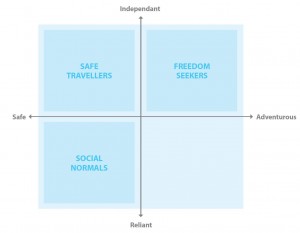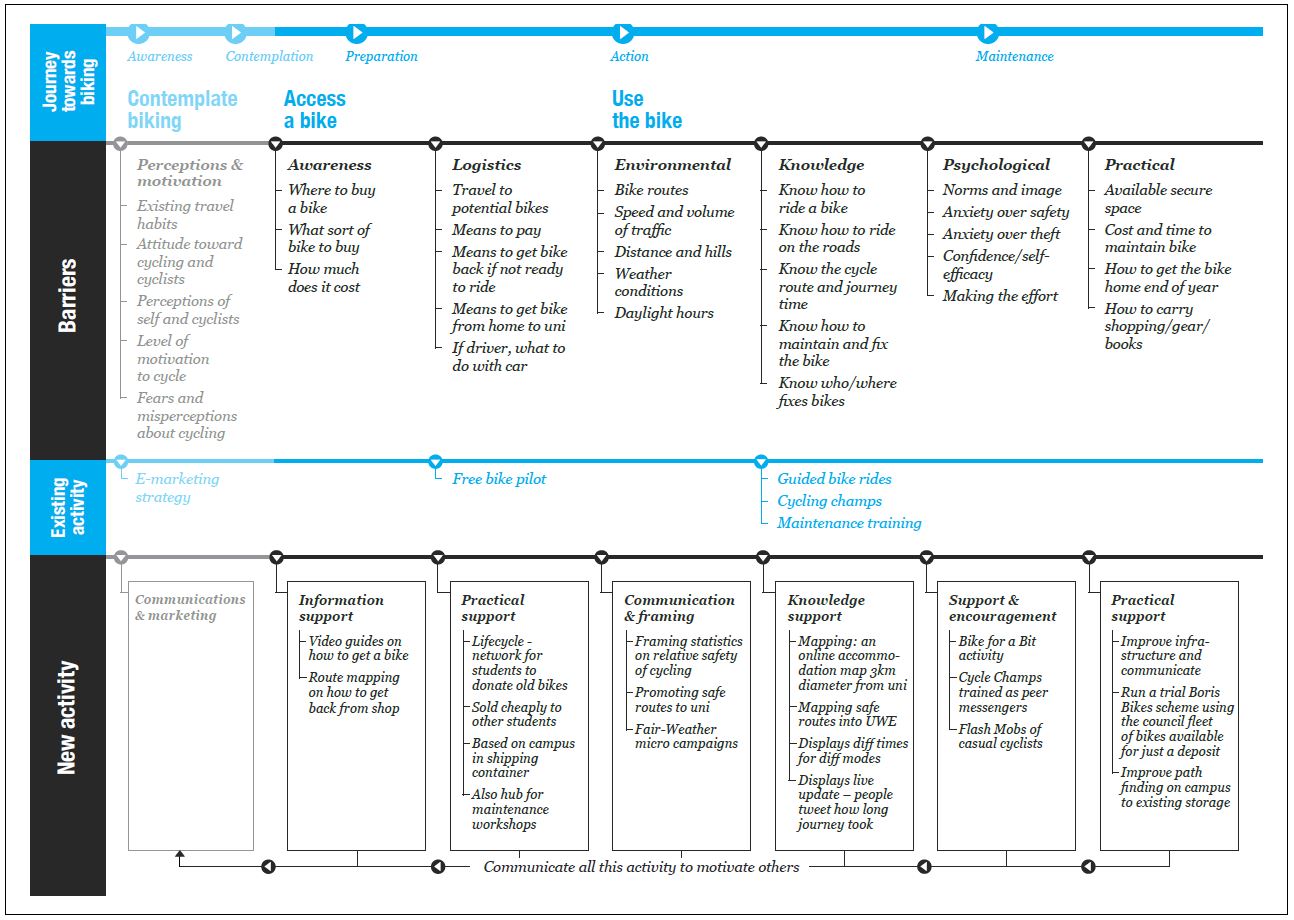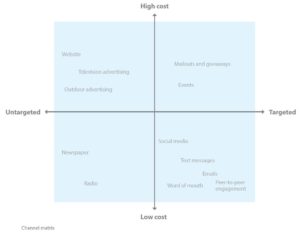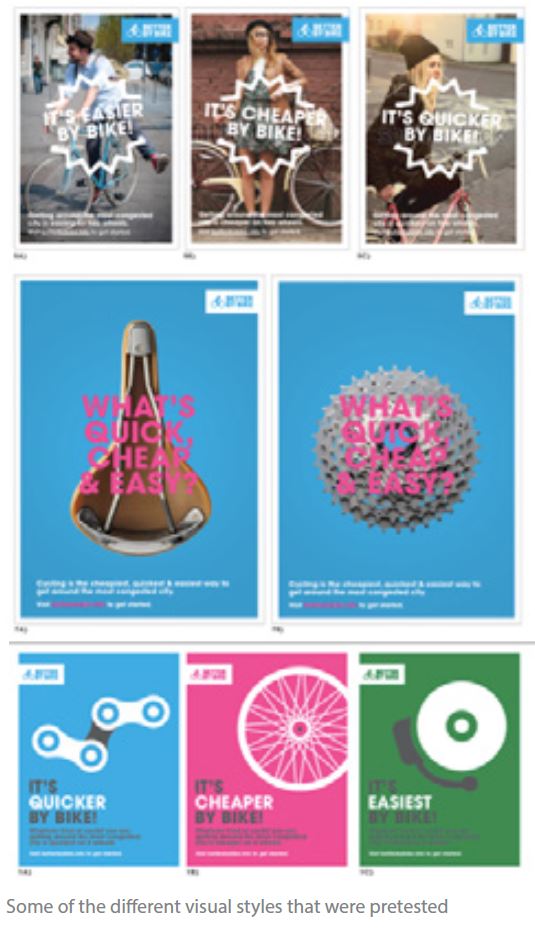Campaign Process and Resources
“Plans are of little importance, but planning is essential” – Winston Churchill
Whether you are planning a small scale campaign or a much larger marketing strategy, taking time before you start to think through your plans carefully, and focus on the change you want to achieve, will save time and support impact.
Getting Started
At this stage think about:
- What is the travel issue or problem that you want to address?
- Break this issue down into the specific behavioural changes and outcomes [preferably Specific, Measurable, Achievable, Realistic, Time-related (SMART)]
- What are the project deliverables or outputs? E.g. social media campaign Who are the primary audience? Staff, students, car drivers etc.
- What budget is available? Will this be internally funded, is there grant money available?
- What staff resource is available? Who will be responsible internally and do they have enough time? Can you get support from your marketing team or go external?
- What are the project timescales? Do you have external deadlines?
- Are there any risks? How might they be mitigated?
Put the answers together into a Project Initiation Document. This will help you keep focused, clearly state the campaigns aims and objectives, and help communicate them to other stakeholders. Confirm who the project manager is (this should be one individual) and if necessary create a steering group.
- Stage: Getting Started
- Duration: 1-2 weeks
- Cost: £0
- Lead: Travel Planner and Project Manager
- Support: Travelwest Business Advisors
- Resources: Project Initiation Document
Tips
-
It is better to focus on fewer rather than many objectives and travel behaviours, unless you have sufficient budget to do so without spreading resources too thin. A campaign with many objectives and insufficient resources risks losing focus, project momentum, and clarity of action. If you want to target multiple travel behaviours considered treating each as a discrete campaign in the scoping, development and implementation stages.
-
Assess whether there is an existing local brand that can be used for the travel behaviour you have selected. Taking behaviours individually aids simple, punchy, compelling messages and calls to action.
Scoping
At this stage you are refining the project scope and carrying out any research that may be required. Who are the key stakeholders?
- Bring together key people and establish support – depending on the intervention this could be senior management, marketing, or student reps.
What do we know already?
- Investigate what has already been done
- refer to sections two and three of this toolkit
- review the sector
- use informal contacts or the EAUC travel & transport network http://www.eauc.org.uk/home
Do we need to know more?
- If required carry out secondary and/or primary research to give further insight into behaviours
- Analysing your insight: two key methods for producing actionable insight that will help to create ideas and interventions are segmenting your audience, and behaviour change journey mapping.
Segmentation
Create a segmentation model for your audience – divide your broad audience into subsets sharing common priorities, barriers, needs, or behaviours. This will allow you to focus efforts where they will be most effective, and differentiate specific marketing strategies to target subsets. Alternatively you can use the segments developed as part of the 2014 Bristol campaign.
Download the segmentation model with descriptions below. Use the common behaviours or priorities as hooks to form your messaging around, and come up with lots of potential messages and ideas to test out in the next stage. Fill in the segment-messaging tool.
In relation to messaging multiple segments there are two approaches:
Multi-segment messages – One approach is to promote messages and ideas that work across multiple segments and are served to the entire student population in a less targeted way. However there is the risk with this approach of diluting the power and effectiveness of the messaging.
Segment specific channels – An alternative approach is to identify and utilise highly focused and targeted channels to deliver messages to specific segments. For example, targeting a fitness conscious segment through hyper local posters or interventions within gyms.
Segmentation model example
Here is an example from the 2014 campaign of how insight can segment your audience. From the primary research carried out for the Bristol Universities, different segments arose from the qualitative insight. The subsets were differentiated by how independent or reliant students are, (primarily in relation to travel) and how adventurous or safe they are (primarily in relation to travel)
The segments are:
- Freedom Seekers – more adventurous, and their independence is very important to them, they do not like being reliant either on public transport or others to get around
- Safe Travellers – similarly independent, but value adventurousness less, and place an importance on safety and security
- Social Normals – much less motivated by independence, are more concerned with safety, and tend to be even more influenced by social norms than other segments Insights into these segments shared priorities and barriers guided the created of a segment messaging plan (extract below):
| Opportunity | Students’ priority for fast transport | Students’ priority for low cost transport | Use the power of social norms, and frame cycling as normal | Support those with low confidence about cycling |
|---|---|---|---|---|
| Messaging aims | Reinforce the perception that cycling is a fast way to travel Tackle any perceptions about driving as a fast way to travel Reduce the perception that cycling involves more time in preparation and afterwards | Reconfigure any misperceptions about the cost of a bike Communicate in a way students can relate to the money they will save Target first years who are not using their free buss pass and second years whose free bus pass has expired | To portray cycling as a social norm for Bristol students Communicate the diversity of types of cyclists to ensure different segments feel included in the norm Use peer messaging to reinforce the perception of group norms | To encourage those with low confidence to take a small step, and try cycling out for just a day A light touch, low commitment required, not changing lifestyle totally Starting small in order to build confidence/perception of safety through positive experiences |
| Segments | Freedom Seekers Safe Travellers | Freedom Seekers Safe Travellers Social Normals | Social Normals Safe Travellers | Safe Travellers Social Normals Freedom Seekers |
Behaviour change journey
Behaviour change is not a one-step process, for an individual to start and maintain a more sustainable travel mode involves a 5-phase transformation journey outlined below.
By understanding the challenges and barriers people face, and motivations to move from one phase to the next, you can put together a strategic campaign that acts comprehensively, providing messages and support throughout the behaviour change journey.
| 1. Awareness | 2. Contemplation | 3. Preparation | 4. Action | 5. Maintenance |
|---|---|---|---|---|
| Aware that active travel is an option | Contemplating whether to walk/cycle to work/ school | Decided and preparing to take action | Started walking or cycling to work/school | Maintenance action for 4 weeks to establish habit |
Create your own behaviour change journey map by deciding where to locate the challenges and barriers revealed by the insight along the phases. Also map out any existing activities and support. This will help to identify any gaps that a communications campaign should aim to plug.
- Stage: Scoping
- Duration: 3-10 weeks
- Cost: £0-£20K+ (depending on research)
- Lead: Project Manager
- Support: Researcher/marketing agency
- Resources: Segment messaging tool
Here is an example of journey map from the 2014 Bristol campaign focusing on mapping the barriers to taking up biking:
Download a blank journey map Download pdf PDF approximately 32.34 KTips
-
The literature review and insight report summarised later in this toolkit were time intensive and costly. If relevant, insight from these reports should be used to develop your future communications and marketing approaches. However, in some cases if your objectives and audience differ significantly, you may want to carry out your own research.
- Develop clear research objectives.
- Have a good understanding of existing research; a literature review may be useful.
- Choose an appropriate methodology – interviews & focus groups are good for understanding attitudes and perceptions and uncovering ideas that may not have been considered. Surveys are good for understanding wider trends and often require much larger sample sets.
- A background in research methods is useful – depending on scope there may be a case to pay for the research (in-house or external).
- If paying for the research there will likely be a choice between an inhouse academic researcher (may be cheaper and bring their own funding but there is risk of time delays and scope creep) or an external marketing agency (more expensive but should be able to meet tight deadlines and will have experience of creating actionable insight).
Developing
You should now have set objectives to impact behaviours and have a good understanding of your target audience.
A specific strategy, campaign or intervention can now be developed.
Prioritising channels
- Take an inventory of the communication channels available to be used, collating data on their reach, owner, primary audience etc. An example can be downloaded below.
- Prioritise which types of channels will be used: to help focus on particular opportunities use the channel matrix which maps out channels depending on how targeted they are (i.e. how good at reaching specific audiences) and how costly they are
Pre-test ideas
- Develop the look or brand (use of BetterByBike or TravelWest may be an option) and content based on the insight into concepts and ideas
- Crucial at this stage is pre-testing of ideas with your audience. This is to check assumptions made based on insight are relevant and actionable
- Create simple mock-ups and examples of the ideas and gather feedback from your audience. Examples of the pre-testing mock ups of images, ideas and events from the 2014 Bristol campaign are include here
- Alternatively if you want to use the marketing materials included with this toolkit it is still a good idea to test these with your audience to confirm they resonate and work. Artwork files are provided on the following page so that any necessary tweaks or amends can be made based on the feedback
Brand guidelines & logos – The West of England region have developed two successful travel brands to support the promotion of sustainable travel messages. BetterByBike is for cycling and Travelwest is for all travel modes. The brands have been used as part of 2014 travel campaign, in particular BetterByBike. Both have a website resource, social media channels and regionally recognised names & logo’s.
Comms Plan
Put together a comms plan of your selected channels and opportunities, marketing activities, and events with details on timings to aid planning, and to provide an oversight of the range of activities. Included for download below is the comms plan for the 2014 Bristol campaign, that details the major opportunities for communications that can be adapted and modified for your campaign. The communications and interventions should be measurable so you can evaluate.
Timings
The first 3-4 weeks of term can be key. Students are still exploring options and open to trying alternatives while the weather is still fair. It appears behaviours are largely been set by November, and this is backed up in research around key transitions. Jan/ Feb can also a great time to talk to 1st year students about location of housing in their second year.
2014 Campaign Materials
Included below are the communications and marketing materials used in the 2014 Bristol campaign. Depending on your audience and travel behaviour, and whether there is the capacity to put on the range of events, you may want to use all, some or none of them if you are developing your own.
- Stage: Developing
- Duration: 5-10 weeks
- Cost: £0-£20K+ (depending on research)
- Lead: Project Manager
- Support: Designer or marketing agency
Resources
Communications Channel List (UWE & UoB) Download xlsx Developing brand guidelines Download zip Pre-tested materials Download zip 2014 Artwork Pack Download zip Example comms plans for new students Download xlsxImplementation
Now that you have your marketing approach, comms materials and plans for interventions you are ready to launch. The tasks you will need to consider include:
- preparing for the intervention launch
- spotting opportunities and dealing with problems during delivery
- monitoring and evaluating the process as it unfolds
- gathering feedback from stakeholders involved in delivery
Depending on the feedback from key stakeholders, you may be required to adjust the implementation plan. A key concern throughout is the successfully delivering the intervention and achieving the desired impact on the target audience’s behaviour within the timescales you have identified.
Social Media – Social media can be used successfully in a number of ways;
- Direct promotion – drawing people to events (bike rides, travel roadshow), signing people up for mailing lists, challenges & promoting new facilities
- Reinforcing desirable behaviours – sharing messages and images to support behaviours and social norms such as cycling. Local and community messages & stories around cycling tend to receive the highest readership rates. Successful examples include; new bike pumps in the city, winter cycling tips, investment for local transport infrastructure.
- Feedback and interaction – particular successes to be had using Facebook Freshers and halls groups (students are very active in these groups with many set-up before arrival). Questions around travel can be responded to and relevant conversation threads can be used to link to campaign messages.
- Stage: Implementation
- Duration: 5-20+ weeks
- Cost: £0-£5k
- Lead: Project Manager
- Support: Volunteers, Travelwest Roadshow, Comms Channel Owners
Tips
-
- This applies especially for new students, but also for any student at the mini-transition of returning each term.
- Students do not all receive information in the same way. In their first year in particular students are bombarded with information, starting from months before they even begin university life.
- The messages that you plan should be well thought out, concise and if possible distributed through several different channels. For instance, a single message or iterations of the message might be emailed, on-line, included in application forms, on social media and in portal messages.
-
- The best events tend to be in the first few weeks of term with students open to new experiences and well marketed in advance, often with the Student Union as the best partner of support.
- Students often approach with simple travel questions, which can open the door to a simplified form of travel planning and advice. Freebies work well to draw people in, in particular food.
- One simple activity is to sign people up to an email list (ie Bike User Group) when they participate in the event so they can be reached in future.
Evaluation and Follow-up
At this stage, the impact of the intervention is formally reviewed and assessed. Evaluation and tracking should have been designed in at development stage, and results captured during implementation. The aim of evaluation is to identify the strengths and weaknesses of your intervention, to check it is making a difference, and measure the return.
Types of evaluation
Simple tracking – people engaged at events, email opens & click-through, social media tracking etc.
Perception surveys – a baseline survey is usually required beforehand as a comparator, and perceptions can be measured before and after the intervention
Travel surveys (ideally annual)
- Online – asking your audience to give info on how they travel. Can include quantitative and qualitative responses and can be relatively cheap and wide ranging. However, respondents bias is an issue (tend to inflate numbers for cycling and walking)
- Cordon Count – on a given day count all the people entering site and interview pedestrians. Comprehensive and accurate but can be expensive and influenced by weather.
Follow-up
The evaluation will have identified which elements worked well, and decisions can be made in terms of what can be repeated. UWE and UoB identified elements of the campaign to be incorporated into ongoing university comms activity and created a Comms Partner Pack with details of the campaign images, messages and a photo-bank.
- Stage: Evaluation & Follow-up
- Duration: 2 weeks
- Cost: £0-£2k
- Lead: Project Manager
- Support: Researcher/agency if external evaluation
- Resources: Evaluation framework



